|
OGRIMMAR
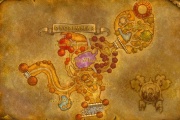
Orgrimmar has been the central hub of the orc community since the end of the Third
War. The city was founded by Thrall and named after his friend and mentor, the former Warchief
Orgrim Doomhammer. It is a fortified complex guarded by stout walls, massive gates and tall towers.
The mountainous ranges of northern Durotar form a natural barrier to the rear of the fortress,
and parts of the complex are carved into the mountain itself.
Orgrimmar is openly hospitable to all members of the Horde and is an important center of commerce.
Visitors may fly into the city by way of zeppelin or wyvern ,
or simply walk through the fortress’s main gates.
People and Culture
Although orcs comprise the majority of the city’s inhabitants, there is a strong troll
presence here as well, primarily in the Valley of Spirits . The simple, rustic architecture
of the orcs is used to maximum effect, creating a network of wooden towers and mud-hut style structures. The Horde races also
use Orgrimmar as a center of trade, not only of physical goods, but ideas as well. For example, a number of different holidays
are celebrated here, including a tauren festival for the winter solstice and a number of others.
Although Thrall’s “new Horde” turns away from demonic influence and the brutish aggression that it was
once known for, some remnants of the Horde’s darker days linger. It is rumored that the Burning
Blade steadily infiltrates Orgrimmar via underground tunnels beneath the city, in the Cleft of
Shadows, a dark cavern where warlocks and rogues dwell.
The most significant figure in Orgrimmar is undoubtedly the warchief himself.
Geography
Orgrimmar is located in the far north of Durotar, at the foothills of the mountain range that separates Durotar from Azshara.
Several valleys have been dug out from the mountain and provide a way of naturally dissecting the city into various zones,
including the Valley of Spirits, Valley of Strength, Valley of Wisdom, and the Valley of Honor.
Several specialty shops are found in the Drag, a dark pathway that leads from the Valley of Strength to the Valley of Honor.
Those searching for potions or training in the darker arts of the rogue or warlock find a tunnel leading down to the Cleft
of Shadow from the Drag.
History
Thrall led the orcs to the continent of Kalimdor,
where they founded a new homeland with the help of their tauren brethren. Naming their new land
Durotar after Thrall's murdered father, the
orcs settled down to rebuild their once-glorious society. The demonic curse on their kind ended,
the Horde changed from a warlike juggernaut into more of a loose coalition, dedicated to survival
and prosperity rather than conquest. Aided by the noble tauren and the cunning trolls of the Darkspear tribe, Thrall and his orcs looked forward to a new era of peace in their own land.
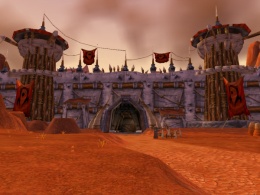
Thunder bluff
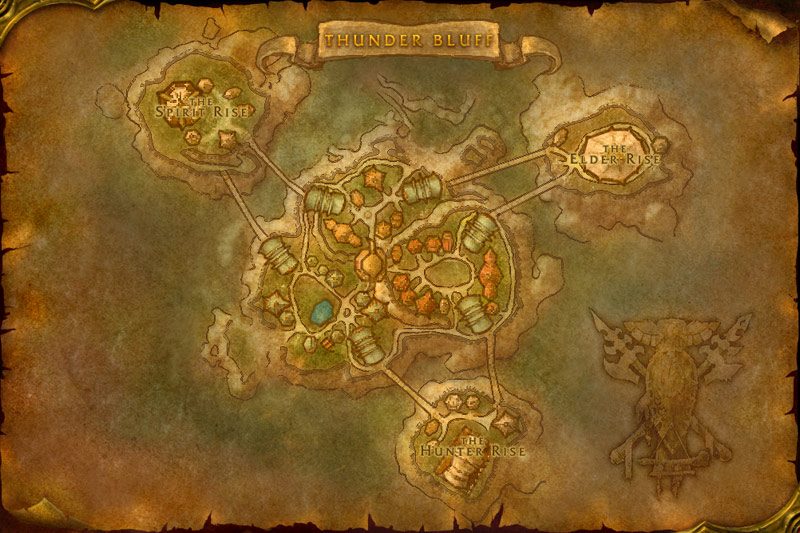
Thunder Bluff was settled fairly recently by the tauren, who successfully drove out the marauding centaur
from their lands. Thunder Bluff is the first city of its kind; for centuries, the tauren wandered the plains as nomads, unable
to claim a permanent home. All Horde visitors are welcome here, and the expertise of the tauren
in the fields of everything from leatherworking to shamanism, druidism to hunting are all taught here. Fortunately, the peaceful nature of the tauren also makes Thunder
Bluff the most accessible of the major Horde cities to Alliance members.
Thunder Bluff’s location makes it resistant to enemy attack. Visitors must either ride wyverns
to one of the four towering mesas that make up Thunder Bluff, or be lifted via rope and wood elevators, an invention unique
to the tauren.
People and Culture
The shamans here conjure them openly, leaving little doubt to the power of their magic. The
tauren constantly work to improve and expand their massive city, which explains how it appeared practically out of thin air.
While some tauren probably regret their departure from a nomadic lifestyle, they all are proud to finally have a home and
spend much of their time trying to make it better. They also are thrilled to have the help of a good number of orcs
and trolls, but less thrilled at the presence of the Forsaken, who they
grudgingly tolerate due to their alliance. The tauren place a strong emphasis on the value of life, and the unlife of the
Forsaken stands as an affront to their beliefs.
Geography
Thunder Bluff is composed of four towering mesas, or rises. The only entrances from the plains below are elevators leading
to the central platform. The central rise is connected to the others through large wooden bridges.
Thunder Bluff is located in the far north of Mulgore, among the sprawling flatlands of the Golden Plains.
Due to its height, the air around Thunder Bluff is thinner than at ground level, but not to the point of being uncomfortable.
Mount Hyjal for example is much, much worse. The weather is almost always warm and sunny, with intermittent breezes carried
in from the Barrens.
History
The centaur were driving the tauren out of their homeland around the time of the Third War.
When Thrall and his Horde arrived on the continent , an alliance
was forged between the Horde and the tauren. Following the defeat of Archimonde and the end of
the war, Thrall helped the tauren rout the centaur and reclaim their land. Shortly thereafter the tauren founded the city
of Thunder Bluff and began the process of settling into their old surroundings and repairing the ecological damage the centaur
had wrought. Thunder Bluff grows and expands at a tremendous rate.
Rises
The various rises in Thunder Bluff act a bit like neighborhoods or quarters in a human city.
Thunder Bluff has a central mesa divided into three rises, surrounded by three additional mesas with distinct names:
- Central Rise (In-game is split in to the Lower Rise, Middle Rise and High Rise)
- Lower Rise (southwestern lifts from main north road)
- Middle Rise (northeastern lifts from plains)
- High Rise (east from wind rider roost)
- Elder Rise (rope bridges from middle and high rise)
- Hunter Rise (rope bridges from lower and high rise)
- Spirit Rise (rope bridges from lower and middle rise)
- Pools of Vision (cave entrance from Spirit Rise)
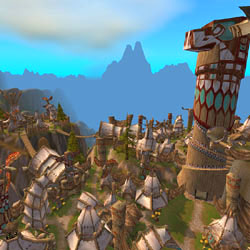

|
|
Undercity
The Undercity is the capital city of the Forsaken
Undead of the Horde. It is located in Tirisfal
Glades, at the northern edge of the Eastern Kingdoms. The city proper is located under the
ruins of the historical City of Lordaeron. To enter it, you will walk through the ruined outer
defenses of Lordaeron and the abandoned throneroom, until you reach one of three elevators guarded by two abominations.
History
Lordaeron s capital city stood for centuries, a monument to humanity’s might.
In the Third War, Prince Arthas slew his father King Terenas
in Lordaeron’s throne room and ransacked the city. He planned to use Lordaeron as his capital on this continent and
ordered his minions to expand the catacombs beneath the city. Then the Lich King summoned Arthas
to Northrend and the work was left uncompleted.
During Arthas’ exodus, Sylvanas Windrunner broke free of the Lich King’s
control and took many banshees and other undead with her. With Varimathras’ assistance she defeated the dreadlords that controlled
the city and set her newly dubbed Forsaken to finish Arthas’ job in the dungeons. The Forsaken
carved Undercity and now rule the surrounding countryside.
Geography
Undercity is an extension of the crypts and dungeons originally beneath Lordaeron’s capital city. The
Forsaken dredged out complex catacombs and caverns. The place is dark, smells like dead people and has an evil feel. Spiders,
oozes and other subterranean creatures occupy the distant passages.
Quarters
- Ruins of Lordaeron (outdoors area beyond and including the entry area)
- Trade Quarter (city center at the bottom elevator exits)
- Rogues' Quarter (southeast from the Trade Quarter)
- Magic Quarter (northeast from the Trade Quarter)
- War Quarter (northwest from the Trade Quarter)
- The Apothecarium (southwest from the Trade Quarter)
- Royal Quarter (south from Apothecarium entrance)
- Sewers (through tunnel west of city)
- Canals (interspaced between the different quarters)
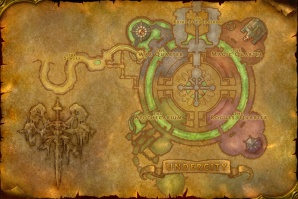
Silvermoon City
Silvermoon City is the capital of the blood elves, located in the northeastern part of
the Eversong Woods within the kingdom of Quel'Thalas. The breathtaking
capital city of the blood elves may rival the dwarven capital of Ironforge
as the world's oldest, still standing, capital. Recently rebuilt from the devastating blow dealt by the evil Prince Arthas, the city houses the largest population of blood elves left on Azeroth.
Silvermoon today is only the eastern half of the original city; the western half was almost completely destroyed by the
Scourge during the Third War. Falconwing Square, the second blood elf
town, is the only part of western Silvermoon remaining in blood elf control. The Dead Scar (the
path taken by Arthas Menethil and his undead army on the quest to resurrect Kel'Thuzad,
which carves through all of Eversong Woods) separates the rebuilt Silvermoon from the ruins of the western half. Interestingly,
the Ruins of Silvermoon house no Undead, instead they contain Wretched and malfunctioning Arcane Guardians. As it stands, what remains of
Silvermoon City is still bigger than other Horde cities.
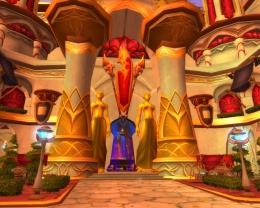
|
 |
|
|
 |
|
|
 |
|
|
|

